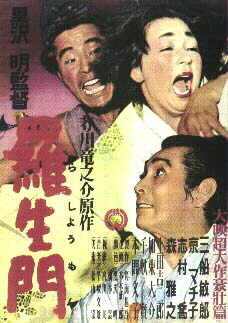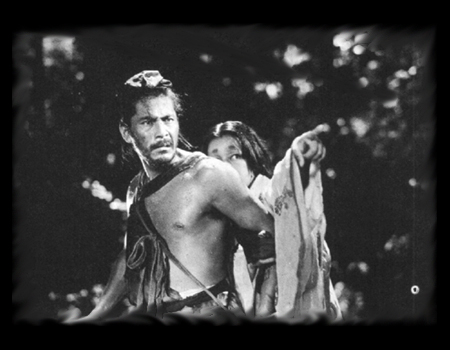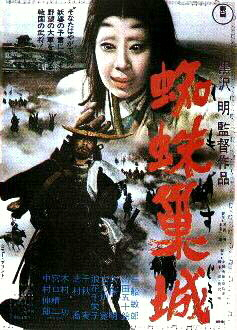
Akira Kurosawa: A Tribute
Kabir Chowdhury
from:
In Akira Kurosawa's death the world lost one of the greatest film-makers of
all the time.
His Rashomon (1950), Seven Samurai (1954), Throne of Blood
(1957) and Yojimbo
(1961), to name only four of his remarkable creations, are glorious monuments
to his
imagination, sensitiveness and ability to handle his chosen themes and establish
his
particular cinematic style.
Kurosawa was directing films since the early forties. However, it was with Rashomon
made in 1950 that he clearly demonstrated his thematic preoccupations and stylistic
penchant.
Rashomon has six sections. The story is at once simple and complex. A
man's dead body
is discovered in a forest with a dagger thrust in his chest. Who killed him?
Why and how
was he killed? The film tries to answer these questions but no clear answer
emerges.
Rashomon opens with two men, a woodcutter and a priest, who sit beneath the
ruins of
the famous Rashomon Gate and tell their story to a third man, a stranger, the
listener.
A furious rainstorm is going on outside. The rainstorm is more than a violent
natural
event. Kurosawa uses it as a concrete external image of two things, firstly,
of the
internal agony of the searchers after truth and secondly, of the lawlessness,
banditry,
famine, war, in other words, the chaotic social instability of the era.
Kurosawa's
ability atusing concrete natural imagery to evoke internal human moods and
emotion is of an exceptionally high order.
One finds ample evidence of it in Throne of Blood, among other films of his.

Poster Rashomon
As a tribute to Kurosawa's greatness I propose to discuss only two of his films
here,
Rashomon and Throne of Blood. As Rashomon proceeds after
the opening scene, we see
the bandit, the woman, the husband--each giving his version of what actually
happened. But there is no unanimity. What led the bandit to attack and rape
the
woman? How did the woman react to the assault? And what was the reaction of
the
husband of the raped woman? As each participant describes the incident we find
that it
differs in fundamental points in human motivation, in the emotional tone, even
in the
sequence of events. Who speaks the truth? Or, doesn't any one, totally, fully?
Does truth
have one face, one voice? Rashomon is, indeed, a great cinematic achievement
at
demonstrating the subjectivity and relativity of truth. But Rashomon
is great also for
Kurosawa's stylistic control of his theme.

We have spoken of three versions of the incident, but there is a fourth one,
too, the
woodcutter's, besides the three direct participants. It was he who discovered
the body in
the wood. He claims that he was an eye-witness. Of what actually took place.
He tells
use that all of them, the bandit, the wife and the husband who was killed, all
were liars.
This is the only true and objective version of the incident. His version presents
the
bandit, the wife and the husband as smaller, weaker and stupider than what they
revealed about themselves in their own telling. But can one implicitly believe
the
woodcutter? Is he, too, lying? Or, is his perception correct? Clearly Kurosawa
introduces
here an element of ambiguity. However, towards the end of the film we find an
attempt
by him to present a more positive view of life, an attempt at synthesizing the
conflicting
versions of the narrators, through a positive human action, a humane action.
The last
scene of Rashomon is very satisfying. After all the violent scenes in the forest,
the
bandit's meeting, pursuit and conquest of the woman, the fierce sword-fight
between the
bandit and the woman's husband, the husband - wife's confrontation scene where
the
wife moves towards her brutally silent husband, as if in a trance, with a knife
in her
handÑafter all these scenes of action, Kurosawa gives us a completely
different picture.
In this last scene we are again among the ruins of the Rashomon Gate. The woodcutter,
the priest and the listener suddenly hear the cries of a little child. Apparently
the baby
has been abandoned by the parents to the storm and the rains. Words, highly
ironic,
pass among the three, at the end of which the woodcutter announces that he will
adopt
the child. Although he already has six children, a seventh one will not make
much
difference. We suddenly realize at this point that the rains have stopped. The
woodcutter
takes his new child in his arms and walks away from the Rashomon Grate. As he
leaves
the ruins of the Gate behind him Kurosawa's tracking camera walks with him.
And we
finally see the sun come out and shine.
A perceptive American critic and film historian's comment on Rashomon is worth
quoting. "Kurosawa's point is that ambiguity, vanity, subjectivity, and
self-interest are
unavoidable facts of human existence, and that certainty, selflessness and objectivity
are unattainable. All that people can do is their best, or what they feel is
their best.
They must assert themselves in action as the they can, realizing that it is
both
impossible to know if the action is really best and to know anything about human
experience except what they 'know' in their own subjective perceptions."
Personally I am
reminded in this context of Pirandello's preoccupation with reality and illusion,
especially in his play "Six Characters in Search of an Author."
Besides the thematic aspect of Rashomon Kurosawa's mastery in establishing
the visual
perspectives and in maintaining the symmetry of the film's structure by keeping
the
location in both space and time very clear in the viewer's mind makes the film
the great
work that it is. Now let us take a look at Kurosawa's Throne of Blood
which is a recreation
of Shakespeare's 'Macbeth', a transformation of the play into a Japanese film.
Kurosawa
sets his story in the Japan of the Middle Ages and makes his Macbeth something
of a
Samurai, though in other respects he follows Shakespeare's plot in Macbeth very
closely.
In Throne of Blood Kurosawa manipulated material reality to create and
project specific
meaning in a very bold and innovative way. For example, in Shakespeare's Macbeth
the
role of Birnam wood is not unimportant but it is really marginal. But Kurosawa
makes
the forest a very important physical presence capable of embodying the film's
complex
network of several themes.

Poster for Throne of Blood
Moral issue is at the heart of Shakespeare's Macbeth. So it is in Kurosawa Throne
of Blood
Macbeth (Wahizu), driven by ambition, subverts the moral order. His vivid but
treacherous imagination inexorably leads him on. He must act out his most horrible
visions, embracing whatever evil he encounters. Finally he is destroyed and
Birnam
wood is the perfect place for his final destruction. In Shakespeare's play,
too, when the
word begins to move defying the laws of nature Macbeth's fate is sealed and
his doom
becomes inescapable. However, in Throne of Blood Kurosawa makes the wood's
role more
explicit and thematically central.
In the words of film critic J. Blumenthal, "the forest is more than a marginal
objective
correlative of the theme. It is both the battleground where the conflict rages
and the
very incitement to conflict."
Kurosawa devotes a large portion of Throne of Blood to the fierce unsettling
spectacle of
Washizu (Macbeth) waging war on the forest. It is a dense forest, a labyrinth.
It is
difficult to find one's way out of it. Kurosawa makes the forest a living presence.
The
forest seems to breathe, sweat, twitch and speak in an incomprehensible language.
Washizu is seized by a sense of dread and helplessness. There is thunder, lightning
flashes and fog. There are strange shrieks and moans. Washizu is determined
to
overpower and defeat this haunting presence but at the end it is he who is overpowered
and defeated by it.
Kurosawa's handling of several scenes in Throne of Blood featuring horses
is superb.
Take, for example, the scene of the old king's murder. There is chaos after
the murder.
All around. After the chaos subsides Kurosawa cuts to the scene next morning.
The
king's horses must have sensed the terrible evil that has taken place and they
are
anxious to run away from it. The frantic rush of the horses to flee the place
again
arouses the castle and chaos is come again. We see the horses galloping away
through a
row of huge banners which flap resoundingly as they are dragged off toward the
forest.
Sight, sound and action coalesce to create a moving scene.
To give another example, in the scene of Miki's (Banquo's) murder we first see
Miki's
horse, usually gentle, suddenly behave crazily. It refuses to be saddled by
the groom.
Miki's son sees in it a bad omen. He tries to dissuade his father from going
and urges him
to abandon his ride and stay for the ensuing banquet. But Miki brushes off his
son's fears
as childish superstition. He rides away on his horse, is way laid a little later
by
Washizu's hired men, and is murdered as planned by Washizu.
In the mean time Miki's men, who were waiting near the castle, speak in hushed
tones
among themselves about the strange turn events took during the last few days.
Suddenly, they hear a noise in the distance. At first it is vague and unidentifiable.
But
soon they recognize it as the sound of the hooves of a galloping horse. And
they
wonderingly see Miki's white stallion come racing into the courtyard, riderless.
Kurosawa at once cuts to Washizu at the banquet hall. We see him staring at
the one
empty seat around the table--the seat reserved for Miki.
Kurosawa demonstrated his independent approach and control over his medium
particularly in the matter of diction. He deliberately abandoned Shakespeare's
superb
language, his colourful metaphors and similes, his wonderful rhetoric. Of course,
Kurosawa's characters speak Japanese. But that is not the point. The most important
thing is that they speak only when they must, only when they cannot communicate
by
gesture or other ways, and when they speak their language is terse, clipped,
brutally
functional. Kurosawa makes other changes in his wok to suit his genius and the
imperatives of the film medium. And he succeeds completely in transforming a
great
Shakespearean play into a great Kurosawa motion picture. In the words of Geoffrey
Reeves, "it is perhaps the only true masterpiece inspired by Shakespeare".
Kurosawa was acclaimed as an original and great filmmaker during his lifetime,
nationally and internationally. His films received a number of prestigious awards
at
home and abroad. In his Samurai films Kurosawa took various elements from the
American Westerns, but in his turn he, too, exercised an impact on the westerns
of USA.
In Seven Samurai Kurosawa used the startling stylistic device of slow
motion in a lyrical
manner to heighten the climactic moment of death in a duel. Very soon it became
a cliche of the new western.
Besides, his Rashomon and Seven Samurai were remade by Hollywood
with the titles of
The Outrage (1964) and The Magnificent Seven (1960) respectively.
Kurosawa is no more with us but his vision and films are. His death has created
a void in
world cinema, especially in the Asian cinematic world. His absence will be felt
long and
deeply.
From Celluloid Number 20, Issue 3, 1998
andthe tribute by Zhang Yimo, the great Chinese
Film director




